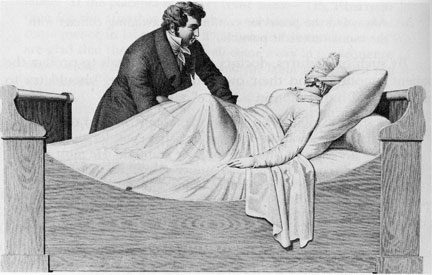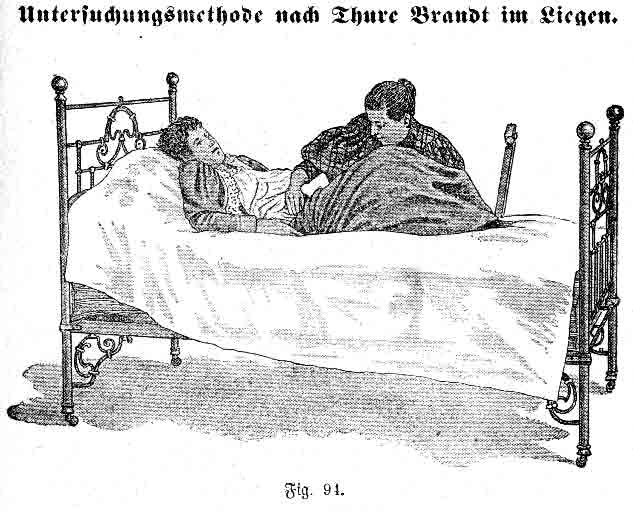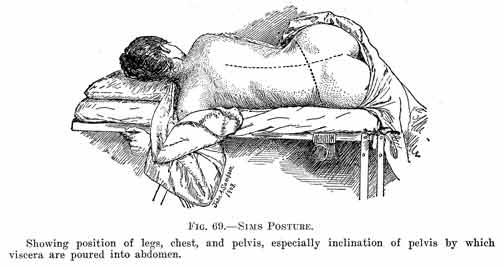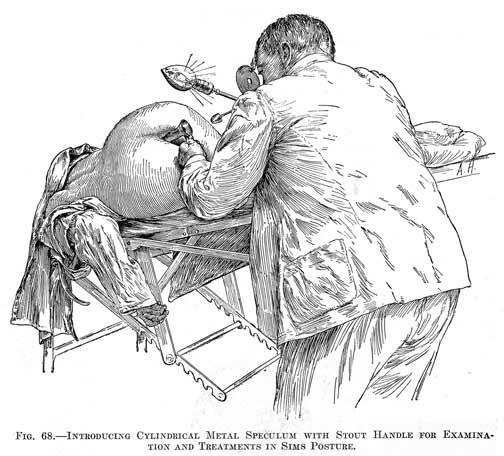Read Dr. Soucasaux on the colposcope, used to
examine the vulva, vagina and cervix of the
uterus.


|

Touch but don't look:
"The Touch" and the shame of physical
examination,
part 2 (part 1)
Examining a bed-ridden
woman followed the same
procedure. In the
illustration right below,
the physician looks the
woman in the eye to give the
impression he's not thinking
about the region his hand is
touching.
|
|
|

From "Lying-In: A
History of Childbirth in
America" by Wertz and Wertz,
Yale, 1989
|
|
Bilz shows (below) a woman
not uncovering the patient's
abdomen while examining her,
although she looks at the
area she touches. The
picture dates from the last
decade of the 19th century
and probably more latitude
was allowed - and the
examiner was a woman.
|
|
|

"Method of examination
lying down according to Thure Brandt"
From Friedrich Eduard Bilz's "Das Neue
Naturheilverfahren," about 1890
|
In the 1840s the American
physician Marion Sims
successfully repaired damage
to the walls of the vagina,
bladder and rectum of some
American slaves he had
bought for this purpose.
Such damaged tissue often
prevented women from
enjoying social life as the
leaking of feces and urine
caused constant soiling and
repellent odor. The slaves,
of course, occupied the
lowest status and had little
choice but to let Sims
attempt, again and again
over years, to surgically
fix the terrible wounds
caused by childbirth - using
no anesthesia. But once Sims
had repaired the tears and
mastered the procedure he
opened probably the first
hospital for women, in New
York, and traveled the world
helping similarly afflicted
women, including European
royalty. It was a huge
breakthrough in gynecology
and demonstrated the power
of actually looking at the
genitals of a patient in
order to help her. The
so-called Sims posture, or
position, below, used by
Sims to access the woman's
perineum, became useful to
other doctors in
examinations because the
woman could not see the
physician, thus maintaining
the emotional distance
achieved by "sightless"
examination procedures that
were now becoming obsolete.
|
|
|

Drawing (1903) from Dr.
Howard Kelly's "Gynecology," 1928,
showing Sims position.
See a Sims speculum
in the museum collection.
|
|

Drawing from Dr. Howard
Kelly's Gynecology, 1928,
showing Sims position.
|
Dr. Howard Kelly, above,
first professor of
gynecology at Johns Hopkins
medical school, was very
religious, a characteristic
prized by the 19th-century
medical establishment
because it helped inoculate
a physician against
suspicion that he might be
interested in more than a
woman's illness. But some of
his famous colleagues at
Johns Hopkins found his
piousness off-putting
although they respected his
enormous influence and
talent. (See more drawings
from Kelly's
book and read about
the founder of the first
university department of
medical illustration in
America, Max Brödel, at
Hopkins, the place these
illustrations originated.)
It's striking that vision
should be the offending
sense here; touch is by
definition physically on
the patient - but was
tolerable. Vision's power in
medicine might be comparable
to that of the Evil Eye in
many parts of the world,
both demonstrating the
strange hold of eyesight. I
wonder if part of the
problem resided in the
doctor's facial expression.
Sometimes patients were
covered with sheets in such
a way as to block their view
of the physician's face.
Several of the facts
and insights on these two
pages I gleaned from
"Lying-In: A History of
Childbirth in America," by
Wertz and Wertz, Yale,
1989.
See the Sim's
speculum in the
museum's collection. Read
Dr. Soucasaux on the colposcope,
used to examine the vulva,
vagina and cervix of the
uterus.
©2004
Harry Finley. It is
illegal to reproduce or
distribute work on this
Web site in any manner or
medium without written
permission of the author.
Please report suspected
violations to hfinley@mum.org
|
|
|






